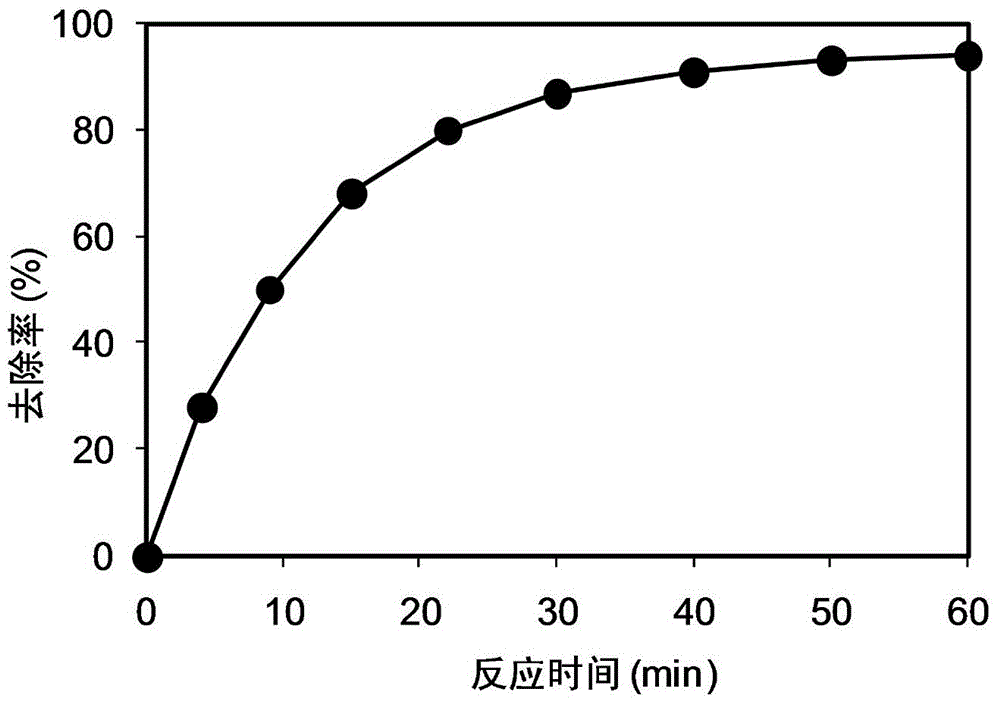Method for removing algae by using inorganic solid peroxide for inducing peroxymonosulfate to generate singlet oxygen
A peroxide and inorganic solid technology, applied in chemical instruments and methods, water/sewage multi-stage treatment, water/sludge/sewage treatment, etc., can solve the problems of complex operation, additional equipment, high investment and operation costs, and achieve Stable chemical properties, convenient transportation and storage, simple and easy operation
- Summary
- Abstract
- Description
- Claims
- Application Information
AI Technical Summary
Problems solved by technology
Method used
Image
Examples
specific Embodiment approach 1
[0019] Embodiment 1: This embodiment is a water treatment method that utilizes inorganic solid peroxide to induce persulfate to produce singlet oxygen to remove algae, and it is realized through the following steps: a. Monosulfate is added to the water area to be treated according to the mass ratio of 1: (0.5~5), and stirred so that the concentration of peroxysulfate in the water area to be treated is 0.5~500mg / L, and the hydraulic retention reaction is 5~ 60min; b. Carry out coagulation, precipitation, filtration, and disinfection in sequence, that is, complete the water treatment of using inorganic solid peroxide to induce persulfate to produce singlet oxygen to remove algae.
[0020] The water treatment process flow of this embodiment is shown in figure 1 .
[0021] The inorganic solid peroxide and persulfate in this embodiment are stored separately before use.
[0022] The inorganic solid peroxide and peroxymonosulfate described in this embodiment can be made into powder...
specific Embodiment approach 2
[0025] Specific embodiment two: the difference between this embodiment and specific embodiment one is that the inorganic solid peroxide is sodium peroxide (Na 2 o 2 ), calcium peroxide (CaO 2 ), magnesium peroxide (MgO 2 ), barium peroxide (BaO 2), sodium percarbonate (Na 2 CO 4 ), potassium percarbonate (K 2 CO 4 ) in one or several mixtures in any ratio. Other parameters are the same as in the first embodiment.
specific Embodiment approach 3
[0026] Specific embodiment three: the difference between this embodiment and specific embodiment one or two is: peroxomonosulfate is sodium peroxosulfate (NaHSO 5 ), potassium persulfate (KHSO 5 ), ammonium persulfate (NH 4 HSO 5 ), calcium persulfate (Ca(HSO 5 ) 2 ), magnesium persulfate (Mg(HSO 5 ) 2 ) in one or several mixtures in any ratio. Other parameters are the same as those in Embodiment 1 or Embodiment 2.
PUM
 Login to View More
Login to View More Abstract
Description
Claims
Application Information
 Login to View More
Login to View More - R&D
- Intellectual Property
- Life Sciences
- Materials
- Tech Scout
- Unparalleled Data Quality
- Higher Quality Content
- 60% Fewer Hallucinations
Browse by: Latest US Patents, China's latest patents, Technical Efficacy Thesaurus, Application Domain, Technology Topic, Popular Technical Reports.
© 2025 PatSnap. All rights reserved.Legal|Privacy policy|Modern Slavery Act Transparency Statement|Sitemap|About US| Contact US: help@patsnap.com


